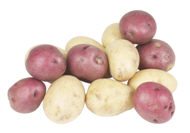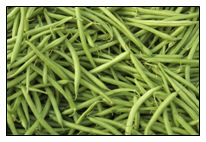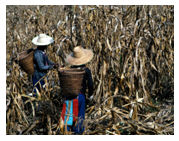Pocket K No. 27: Biotechnology and Biofortification
| |
The Ideal Diet: Sufficient and Balanced
A major challenge of our time is that one sixth of the world’s population suffers from hunger, a situation which is totally unacceptable. In addition, many more people, over half of the global population, are afflicted by a different form of food deficiency (FAO, 2004). This “hidden hunger” is due to the quality, rather than the quantity, of the food available, and it is closely related to the fact that in many poor developing countries people rely only or mostly on low-protein staple crops for food.
Nutrient deficiencies pertain mainly to proteins and micronutrients like vitamin A, iron, zinc, selenium and iodine. Conventional strategies to combat nutrient deficiencies include dietary supplements and food fortification programs. These programs, however, present several problems: the target populations are often not reached (especially in poor rural populations in developing countries); they are often not sustainable over time; and they address mostly the symptoms rather than the underlying cause of the problem.
 An adequate and diverse diet, comprising fruits, vegetables and animal products, is the best solution for good nutrition both in terms of energy requirement and micronutrients needs. However, this remains out of reach for a large proportion of the world’s population. Introducing biofortified staple crops with increased nutritious content can therefore have a very big impact, as the strategy relies on improving an already existing food supply (Nestel et al., 2006).
An adequate and diverse diet, comprising fruits, vegetables and animal products, is the best solution for good nutrition both in terms of energy requirement and micronutrients needs. However, this remains out of reach for a large proportion of the world’s population. Introducing biofortified staple crops with increased nutritious content can therefore have a very big impact, as the strategy relies on improving an already existing food supply (Nestel et al., 2006).
Biotechnology and Biofortification
Biofortification capitalizes on the consistent daily intake of food staples, thus indirectly targeting low-income households who cannot afford a more diverse diet. After the initial investment of developing fortified crops, no extra costs are met, making this strategy very sustainable. Furthermore, the improved varieties can be shared internationally. Biofortified seeds are also likely to have an indirect impact in agriculture, as a higher trace mineral content in seeds confers better protection against pests, diseases, and environmental stresses, thereby increasing yield (Welch and Graham, 2004). Biofortification is not a panacea in itself but a very important complement to dietary variety and to supplementation.
Biofortified crops can be developed by traditional breeding methods, provided there is sufficient genetic variation in crop populations for the desired trait (such as high protein content). In staple grains such as rice, improvement of some complex traits such as vitamin A is not possible using conventional breeding strategies, as there are no natural rice varieties rich in this vitamin. All plants produce pro-vitamin A, but only in the green organs of the plant and not in the starch-storing part of the seed. Conventional breeding is also very difficult in vegetatively propagated varieties (such as cassava and potatoes), due to the scarcity of genetically well-defined breeding lines. In addition, conventional breeding can change important traits of the crops desired by consumers, such as taste. Agricultural biotechnology methods, and in specific genetic engineering (GM), represent therefore a very valuable, complementary strategy for the development of more nutritious crops.
Crops for Biofortification
A significant portion of the developing world’s population relies largely on one or more of the staple crops for their nutrition, and these are the subject of biofortification projects, both by conventional breeding and by modern biotechnology methods. Rice, the world’s most important cereal crop for human consumption, is the food staple of more than 3 billion people, many of them very poor. Maize constitutes a staple human diet in at least 22 countries, mostly in Africa and Latin America. Wheat is a very important human food grain and the staple food for 35% of the world’s population. Potato is the most important non-cereal food crop, and ranks fourth in terms of total global food production. Cassava feeds about 800 million of the world’s most deprived populations, mostly in Africa.
Biofortification for Increased Protein Content
 Human cells can produce only 10 out of the 20 amino acids, the building blocks of proteins, and so the missing essential amino acids must be supplied in the food. As the body cannot store excess amino acids, their intake must be daily. In many poor developing countries, the daily intake of essential amino acids is often not sufficient due to the scarcity of high-protein sources such as meat, fish, or soybean. Rice, cassava and potato are important sources of carbohydrates, but they are low in protein content.
Human cells can produce only 10 out of the 20 amino acids, the building blocks of proteins, and so the missing essential amino acids must be supplied in the food. As the body cannot store excess amino acids, their intake must be daily. In many poor developing countries, the daily intake of essential amino acids is often not sufficient due to the scarcity of high-protein sources such as meat, fish, or soybean. Rice, cassava and potato are important sources of carbohydrates, but they are low in protein content.
Suitable protein candidates for biofortification include the storage protein Sporamin A from sweet potato, the seed albumin AmA1 protein from Prince’s Feather (Amaranthus hypochondriacus), and ASP1, an artificial storage protein rich in essential amino acids. ASP1 has been introduced and expressed successfully in rice and cassava, and efforts are under way to optimize expression and increase the level of protein accumulation in transgenic plants.
Combating Vitamin A Deficiency
Vitamin A deficiency, particularly prevalent among children in Africa and Southeast Asia, causes irreversible blindness, and increased susceptibility to disease and mortality. Rice plants produce β-carotene (provitamin A) in green tissues, but not in the seeds. A public-private partnership to produce rice varieties rich in provitamin A culminated in the development of Golden Rice, in which two genes were introduced by genetic engineering.
These encode the enzymes phytoene synthase (PSY) and phytoene desaturase (CRTI). Golden Rice 1 contains the PSY gene from daffodil and the CRTI gene from the bacterium Erwinia uredovora, both expressed only in the rice seed (Ye et al., 2000). Replacing PSY with genes from maize and rice increased the level of β-carotene by 23 times in Golden Rice 2 (Paine et al., 2005). Half the daily recommended allowance of vitamin A for a 1-3 year old child would therefore be provided for in 72g of Golden Rice 2. Golden Rice is in advanced testing stages, and is expected to be released in a few years.
In addition to rice, other crops engineered for higher β-carotene content include potato, canola, tomato, carrot, and cauliflower (Sautter et al., 2006; Diretto et al., 2007).
Iron-rich Crops Against Anemia
 Iron deficiency anemia affects more than 2 billion people in virtually all countries, which makes iron deficiency by far the most common micronutrient deficiency worldwide. Iron is found in vegetables, grains, and red meat. However, the bioavailability of iron in plants is low, and in rice, the problem is aggravated by the presence of phytate, a potent inhibitor of iron resorption, and by the lack of iron resorption-enhancing factors.
Iron deficiency anemia affects more than 2 billion people in virtually all countries, which makes iron deficiency by far the most common micronutrient deficiency worldwide. Iron is found in vegetables, grains, and red meat. However, the bioavailability of iron in plants is low, and in rice, the problem is aggravated by the presence of phytate, a potent inhibitor of iron resorption, and by the lack of iron resorption-enhancing factors.
Therefore, scientists had to increase the iron content in grains, reduce the level of phytate, and add resorption-enhancing factors (Sautter et al., 2007). Expression of the iron storage protein ferritin from French bean and soybean in the endosperm of rice results in a 3-fold increase of iron in seeds. In order to decrease the level of phytate, an enzyme that degrades it (known as phytase) has also been transformed into rice, and efforts are currently under way to optimize the construct. Finally, over-expression of a cysteine-rich protein that transports metals in rice can improve the rate of iron resorption during digestion.
Increased Folic Acid in Tomato
Folic acid deficiency is a global health problem that affects mainly, though not exclusively, women over the age of 30, and it is the main cause of anemia in at least 10 million pregnant women in developing countries.
In food, most of the folic acid occurs as folate. In order to engineer tomatoes with higher level of folate, scientists have over-expressed in the fruit the genes encoding the enzymes catalyzing the synthesis of two folate precursors (Díaz de la Garza et al., 2007). In plants were both traits were combined by crossing, vine-ripened transgenic fruit accumulated up to 25 times more folate than controls.
Challenges for the Adoption of Biotech Biofortified Crops
A major problem of developing fortified crops is the cost of research and of regulatory compliance, due to due to the extreme precautionary regulation of biotech crops. In the case of biofortified crops, where profit margins for private technology developers are slim, the scarcity of public funds exacerbates this problem (Powell, 2007).
GM technology tends to be proprietary, so intellectual property (IP) issues also need to be duly considered. As many as 16 patent and 72 intellectual property issues had to be resolved in the process of making Golden Rice available to poor farmers at no cost (http://www.goldenrice.org/). A successful biofortification strategy requires widespread adoption of the crops by farmers and consumers, and this presents several important challenges (Powell, 2007). Public acceptance is also essential, especially if the new trait changes perceptibly the qualities of the crop, such as color (like in Golden Rice), taste, and dry matter content. Adequate information programs will play an essential role in ensuring acceptance.
Wide dissemination of the technology, a requisite for success, also relies on good market networks and channels for the dissemination of agricultural information. The lack of agricultural infrastructure in some developing countries, especially in Africa, is a significant challenge for adoption of new biofortified varieties.
Conclusion
 Biofortified crops, either by conventional breeding methods or by modern biotechnological tools, are not a panacea. The ultimate aim in global nutrition remains a sufficient and diverse diet for the world’s population. However, biofortified crops can complement existing micronutrients interventions, can have a significant impact on the lives and health of millions of people, especially those most in need.
Biofortified crops, either by conventional breeding methods or by modern biotechnological tools, are not a panacea. The ultimate aim in global nutrition remains a sufficient and diverse diet for the world’s population. However, biofortified crops can complement existing micronutrients interventions, can have a significant impact on the lives and health of millions of people, especially those most in need.
| |
References:
Díaz de la Garza R. et al. (2007). Proc Natl Acad Sci U S A. 104: 4218–4222.
Diretto G. et al. (2007). PLoS ONE 2: e350. doi: 10.1371/journal.pone.0000350.
FAO. (2004). http://www.fao.org/docrep/006/Y5160E/Y5160E00.htm.
Nestel P. et al. (2006). J. Nutr. 136: 1064-1067.
Paine JA, , et al. (2005). Nat.Biotech. 23:482-487.
Powell K. (2007). Nat. Biotech. 25: 525 - 531.
Sautter C. et al. (2006). Proc. Nutr. Soc.65:153-159.
Welch R. M. and Graham R. D. (2004). J. Exp.Bot. 55: 353-364.
Ye X. et al. (2000). Science 287:303-305.
